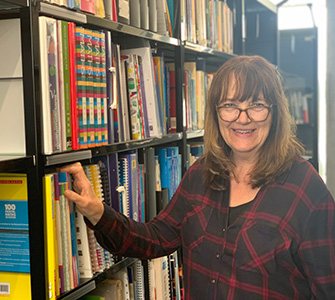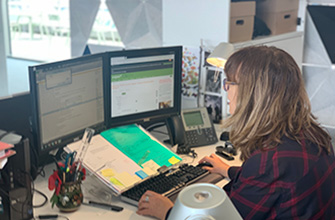
Fiona Beedle is the librarian at Cambridge Assessment.
How would you characterise your current work?
I am the University of Cambridge Departmental Librarian for Cambridge Assessment, looking after about 8,000 items, which include books and journals on assessment and course and study books for all the disciplines such as maths, English, biology, etc. As we moved to our new building this past year I am currently cataloguing all the books which were donated at that time by the different divisions within the business and will shortly be overseeing the incorporation of the previously separate Cambridge English library into this one.
I really enjoy my work, especially working with the logic of organisation and presentation – a library is ultimately presentation in a logical way so that people can clearly and easily find what they are looking for. Another aspect I find particularly interesting is the challenge of getting into the thought processes of how others have categorised items, such as when I am trying to find a specific journal article from another library for a member of staff.
How do you feel about maths?
Scared! Maths does not come naturally to me, and I believe that ideally children should find numbers fun. I was number blind as well as dyslexic and neither of these conditions was recognised when I was a child, so maths was fearsome for me and at school it was a nightmare – I was considered so bad that the school didn’t let me take any exams in it.
When my children were doing maths at school in the early 1990s I didn’t understand what they were doing with their homework and couldn’t help them. I was also looking at applying for a university course at that time, so I decided to take a GCSE in maths and with the help of a wonderfully patient tutor I did it in a year. I can now see there are patterns in maths and I imagine for others it would be fascinating and addictive, but I still don’t have the confidence with numbers to enjoy it.
What is it about your work that is mathematical?
On a day-to-day basis I work with Dewey Decimal Classification to apply both accession and classification numbers to the items in the library. The Dewey system is complex, using a logical progression of numbers to help categorise and then easily find each catalogued item. When visiting other departmental libraries, I not only need a good understanding of it but also an ability to memorise these numbers in order to find the book(s) I need – especially when looking for maths books which tend to have very long classification numbers!
I also use financial calculations for my work, keeping careful track of the library’s budget and ensuring that all external charges are accurate. When deciding to buy a book for the library I need to compare prices and ascertain the best value against the quality of the options available for that item. Then when I am sourcing copies of articles or book chapters for staff I need to ensure that I use the best value source, whether that be to use the copying service of another library or to obtain the item myself and copy it. Time and resource management factors come into play here as well.

How do you use maths, calculation or numeracy in your work? What tools do you use to help you?
When setting up the new library here at Triangle I needed to estimate the total shelf space I would need for all of the current books in the library as well as those which would be donated to it as a result of the move. Shelf space is calculated in ‘shelf meterage’ and does not necessarily correspond to the number of books in the library, as books come in all shapes and sizes!
To help me with my own use of the Dewey system I use a spreadsheet; I also consult the online British National Bibliography and Copac, which is an online combined catalogue of the UK’s national libraries, many university libraries and specialist research libraries.
Do you think maths is creative? If so, how?
I wouldn’t say maths is creative in itself, but its application is extremely creative – my son is an architect and the way he uses maths is vital for his creativity, as it would be for a designer, or for a chef. There are so many creative applications for maths that I can think of.
Do you use or rely on any maths that you learnt in school?
As I got so confused at school and didn’t really learn any maths there I cannot say that I use anything from that time. It is only as I have matured that I have begun to appreciate, and apply, the organisational logic of number systems.
How would you change the school curriculum, if you had the chance? Why?
I would make it far more applicable to the real world, to nature and to the interests and hobbies of the students. When I was at school you had a book with lined or squared paper and you’d do all your work on that. It wasn’t until I was doing my maths GCSE in the early 1990s and I had to work out a train timetable for it that the penny dropped that this might be useful. Since then I have realised that I also use maths in one of my hobbies – researching my family history – where I need to work out people’s ages and their potential relationships from dates on old documents.
Household items are great for comparing weights and measures – an ounce of icing sugar and an ounce of demerara sugar are totally different in many ways! This kind of real-world application would help students understand what they were doing, and they would obtain the life skills they needed for using numbers.
It’s also really important for students to feel comfortable asking questions – admitting that they don’t understand and being able to share that to help everyone to understand properly.
Join the conversation: You can tweet us @CambridgeMaths or comment below.